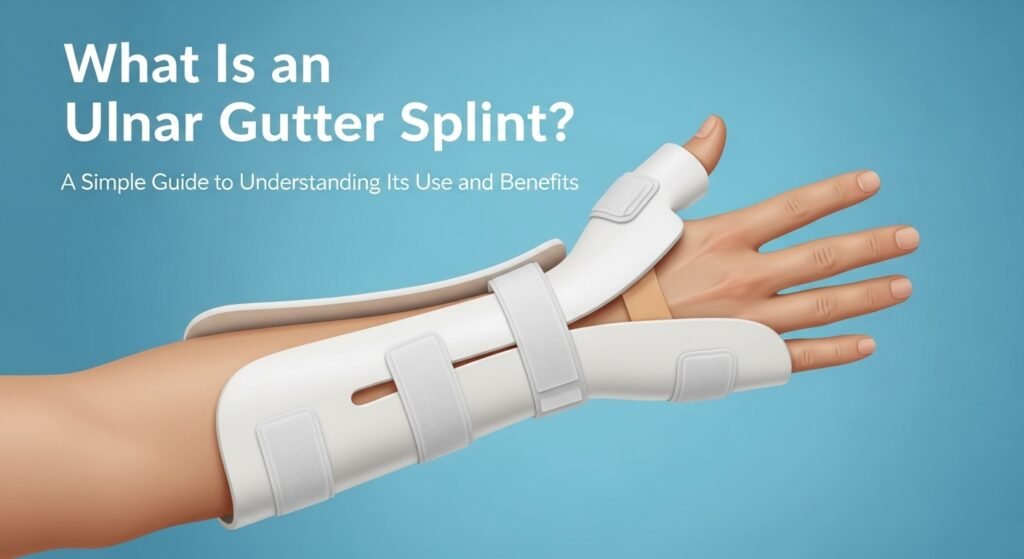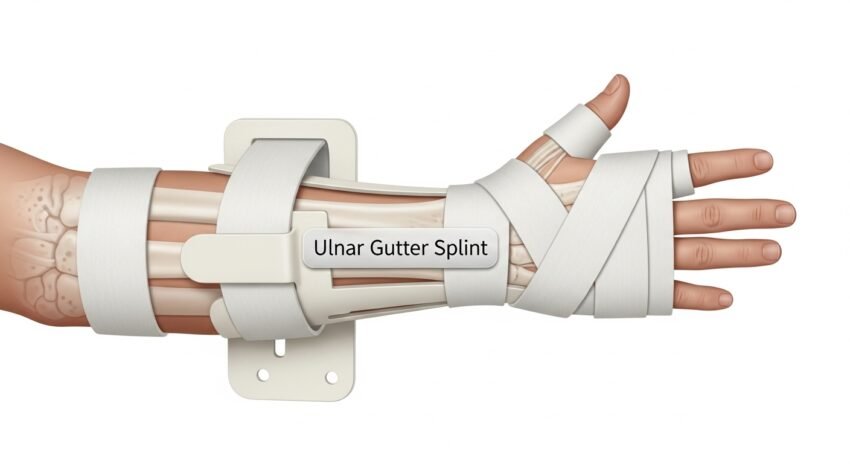Table of Contents
If you’ve ever injured the side of your hand with the pinky finger or ring finger, a doctor may have mentioned using an ulnar gutter splint. At first, that name might sound a bit complicated—but don’t worry. We’re here to break everything down in a simple, friendly way that’s easy to understand, even if you’re not a medical expert. An ulnar gutter splint is a type of support used to protect certain fingers and part of the hand and wrist while they heal. Whether you’re dealing with a fracture, sprain, or soft tissue injury, this tool plays an important role in recovery. In this helpful guide, we’ll explain what an ulnar gutter splint is, when it’s used, how it works, and what to expect during the healing process. We’ll also cover how to care for the splint and make sure your recovery goes smoothly. Let’s start by learning all about this helpful and supportive device.
What Is an Ulnar Gutter Splint?
An ulnar gutter splint is a stiff support that wraps around the outer (ulnar) side of your forearm, wrist, and hand. It holds the ring finger and pinky finger in place to keep them from moving, giving injuries time to heal. The splint is shaped like a “gutter” or a small channel, which is where those fingers rest. It’s usually made from a soft but strong material like plaster, fiberglass, or foam, and it’s wrapped with bandages so it stays secure. This type of splint is often used after injuries like broken fingers, sprains, dislocations, or tendon damage. Doctors use it when they want to immobilize the hand without using a full cast. It’s commonly the first step in treatment for certain arm or hand injuries.
What Injuries Need an Ulnar Gutter Splint?
Ulnar gutter splints are used for specific injuries on the pinky side of the hand. Here are some common examples:
- Boxer’s fracture: A break in the bone of the pinky finger
- Metacarpal fractures: Breaks in the long hand bones under ring and pinky fingers
- Phalangeal fractures: Bends or cracks in the pinky or ring finger bones
- Tendon injuries: Damage to muscles and tendons controlling finger movement
- Soft tissue sprains: Severe overstretching of the finger joints or ligaments
These injuries often happen during falls, sports, or after punching something with a closed fist. The ulnar gutter splint helps stabilize the bones so they can heal in the right place.
How Does an Ulnar Gutter Splint Work?
The main job of an ulnar gutter splint is to keep your injured fingers still. Movement can slow healing or make the injury worse. By holding the affected fingers and part of the hand in one solid position, the splint lowers pain, reduces swelling, and protects the injury. While wearing the splint, your fingers are usually gently bent in a natural curled position. Doctors call this the “safe position” because it lowers the chance of future stiffness. The splint may also help avoid surgery in some cases by allowing the bones to heal naturally in the correct place.
How a Doctor Puts on an Ulnar Gutter Splint
Applying an ulnar gutter splint takes skill. A medical professional will start by examining your injury. If the hand is very swollen, they may wait until swelling goes down before splinting. Here’s how it’s usually done:
- Soft padding is wrapped around your wrist, hand, and pinky side of the forearm.
- The splint material is shaped to fit the contour of your arm and hardened to form a supportive shape.
- The fingers are gently placed in a curled position and wrapped to prevent shifting.
- The whole setup is secured using an elastic bandage.
The process doesn’t usually hurt, and your doctor may check that blood flow to your fingers stays normal during and after.
What to Expect While Wearing an Ulnar Gutter Splint
Once the splint is in place, you’ll need to use your opposite hand for most tasks. The fingers inside the splint will be immobilized, so you’ll need to avoid lifting, bending, or using your injured hand for a while. Swelling or tightness is normal at the beginning, but it should get better. You might feel itching or warm spots under the splint, but don’t remove it or try to scratch. Just keep it dry and follow your doctor’s care instructions. You’ll also return for regular visits so they can check how your healing is going.
How Long Do You Wear an Ulnar Gutter Splint?
The amount of time you’ll need to wear the splint depends on your injury type and how well you heal. Most people wear an ulnar gutter splint for 2 to 6 weeks. For simple fractures, it might be shorter. For more serious injuries, your provider might recommend longer immobilization or follow the splint with a cast. Sometimes, after healing starts, the splint can be removed briefly for cleaning or light movement exercises. Your doctor or physical therapist will guide you through the process so you don’t risk re-injury.
How to Take Care of Your Ulnar Gutter Splint
Keeping your splint clean and safe helps it work better and prevents skin issues. Here are a few tips:
- Keep it dry: Never shower or bathe with the splint unless you cover it with a plastic shield.
- Don’t remove it unless your doctor allows it.
- Watch for red skin or sores around the edges and let your doctor know.
- Don’t stick objects like pens or rulers inside—even if it itches. This can cause cuts or infections.
- Avoid bumping or using your hand until the doctor says it’s okay.
If your splint gets too loose, too tight, or wet, call your provider for instructions.
Can You Drive with an Ulnar Gutter Splint?
Driving with an ulnar gutter splint on isn’t safe for most people. It can affect your ability to grip the steering wheel or handle emergency stops. Laws about driving with a splint vary depending on your location, but in general, it’s not advised unless your doctor says it’s okay. If the splint is on your dominant hand or the hand you use to shift or steer, wait until you’re healed. Ask family or friends to help with rides or use public transport if needed. Keep your safety and the safety of others in mind.
Exercises After Splint Removal

Once your time in the ulnar gutter splint is over, your hand might feel weak or stiff. That’s normal. Your doctor or physical therapist may recommend gentle exercises to get your hand and fingers moving again. These may include:
- Finger curls and extensions
- Wrist rotations
- Thumb stretches
- Squeezing soft balls to boost grip
Start slow and don’t push through pain. Recovery takes time, but steady progress will help you return to normal activity. Keep using any therapies suggested, and ask questions if anything feels off during this stage.
Differences Between an Ulnar Gutter Splint and a Cast
While both split and cast support healing, they’re not the same. An ulnar gutter splint is usually used right after an injury before swelling goes down. It can be adjusted or removed (by a doctor). A cast, on the other hand, is hard all around and stays on for several weeks without being removed. Some patients begin with a splint and later get a cast as swelling improves. Your doctor decides what’s best based on your injury and healing stage.
Can You Sleep with an Ulnar Gutter Splint On?
Yes, you should always sleep with your splint on unless your doctor tells you otherwise. Taking it off at night could allow fingers or your wrist to shift, delaying healing. It’s best to prop your injured arm on a pillow to keep swelling low while you sleep. If you feel pressure, numbness, or tingling while lying down, try changing position or raising the arm higher. If the issue continues, tell your doctor, as your splint may need adjusting for comfort and safety.
How Effective Is an Ulnar Gutter Splint?
When used correctly, an ulnar gutter splint is very effective at helping injuries heal naturally. It reduces the risk of further damage and often removes the need for surgery. For minor fractures and soft tissue injuries, it’s often the first and best choice. People who follow care instructions closely tend to heal faster and regain more use of their hands. As always, follow your doctor’s advice, attend your follow-up visits, and don’t rush the process. Healing well now helps you avoid problems later.
FAQs
1. What is an ulnar gutter splint used for?
It supports and protects injuries to the pinky and ring fingers, especially fractures or tendon issues.
2. Is a splint better than a cast?
A splint is often used early or for mild injuries. Depending on healing, some people switch to a cast later.
3. Can I remove the splint to shower?
Only if your doctor allows it. Otherwise, keep it dry and use a shower cover to protect it.
4. How tight should the splint feel?
The splint should feel snug but not painful. If your fingers feel numb, call your doctor right away.
5. What happens after splint removal?
You’ll probably need gentle hand exercises and time to rebuild strength and motion in the fingers.
6. Can an ulnar gutter splint heal a broken bone on its own?
Yes, for many small breaks, a splint can help bones heal without surgery, as long as it’s used correctly.
Final Thoughts
An ulnar gutter splint may seem small, but it plays a big role in healing hand and finger injuries. From helping broken bones stay in place to easing the pain of tendon strains, this smart little device gives your injury the quiet time it needs to repair. By learning how it works, how to care for it, and what to expect, you’re already one step ahead in your recovery journey. Stay patient, listen to your doctor, and take each day as it comes. Before long, your hand will be back in action—and stronger than ever!
